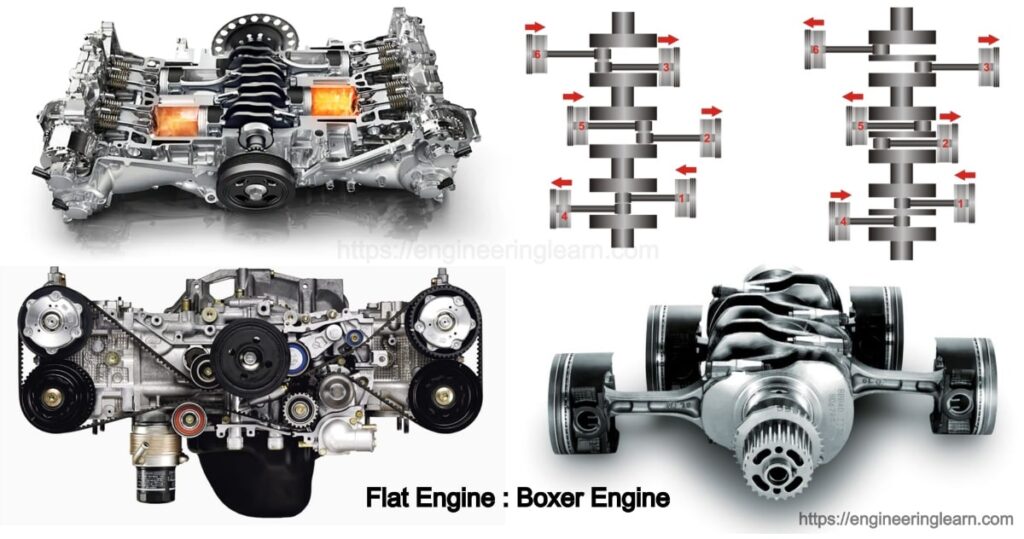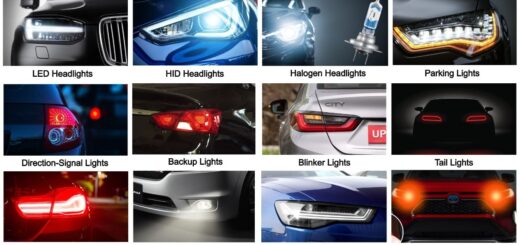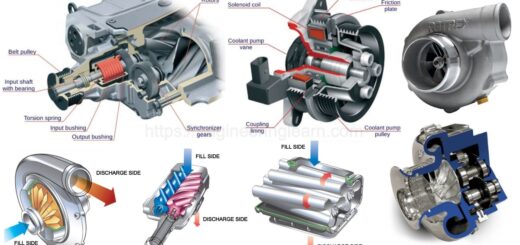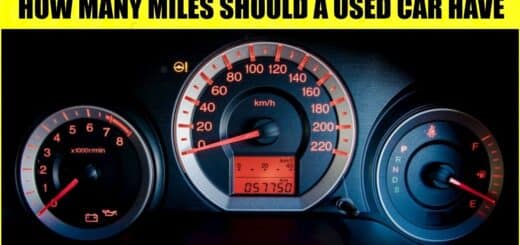Flat Engine: Boxer Engine & Water Cooled Engine [Complete Details with History]

What Is A Flat Engine?
Flat Engine: Boxer Engine & Water Cooled Engine :- A flat engine is also referred to as a horizontally opposed engine which has a piston engine in which the cylinders are located on the either sides of a central crankshaft. It is an effect version of a V engine with a 180-degree angle between the cylinder banks. A flat engine should not be confused with the opposed-piston engine as there each cylinder has two pistons which share a central combustion chamber. This is what makes it the most common configuration of a flat engines which is also known as a boxer engine, wherein the each pair of opposed cylinder moves inwards and outwards at the same time.
The other name of this configuration is known as 180-degree V engine which has a crankpin that is shared by a pair of cylinders. However, boxer engines are one of the common type of flat engines that may not necessarily be flat engines.
The first flat engine was made in the year 1897 by Karl Benz. These are the engines which have been used in various aircrafts, motorcycles and automobile applications which are now not that common as compared to the straight engines (the engines with less than six cylinders) and V engines (the engines with six or more than 6 cylinders) in cars, whereas are more popular in the aircrafts where the straight engines are quite rare and V engines have almost extinct other than the historical types which have also been replaced by the radial engines in many smaller installations.
Flat Four Engine or Boxer Engine
What Is A Boxer Engine? : Flat-four engines are a type of flat engines which are designed in such a way that each pair of the opposing pistons moves either inwards or outwards at the same time, which is well known as a boxer configuration. Therefore, there are two terms flat-four and boxer-four which are often used as a synonym.
The merits of the boxer-four layout are perfect for a secondary vibration with low Centre of gravity, and a short engine length. The layout lends itself to an efficient air cooling system with the airflow being distributed evenly across the four cylinders. This system is used in the aircrafts which avoids the need to carry heavy water cooling systems.
The bottom of the boxer-four engines are provided with extra width which increases the costs associated to the two cylinder heads instead of one, also the long exhaust manifold requires to achieve even space exhaust pulses. These are the factors which make inline-four engines more popular as compared to flat-four engines whereas the V6 engines are often used where there is larger displacement required.
Engine Balance: ( Flat Four Engine or Boxer Engine )
The force generated is either equal or opposing which is generated inside a boxer-four engine that results in a perfect secondary balance unlike the unbalanced forces produced in inline-four engines. Therefore, the boxer-four engines are suited well to displace them as they do not require balance shafts in order to reduce the secondary vibration.
Each cylinder set inside a boxer engine is slightly offset with respect to its opposing pair which creates a distance between the crankpins along the crankshaft. This distance is kept to keep an equal or opposite forces from each cylinder pair which is found producing a couple force. The results in the vibrations which are not usually high enough to require the balance shafts.
Exhaust Manifold:( Flat Four Engine or Boxer Engine )
The exhausts are merged from the two cylinders on each bank which results in the uneven exhaust pulses that causes a characteristic exhaust sound.
The other common exhaust configuration like Subaru is to pair the cylinders within a fixed firing interval offset set at an angle of 360 degrees, in order to optimize the exhaust pulses. This configuration requires a long exhaust manifolds which helps to pair the cylinders on the opposite banks which results in a less distinctive exhaust sound.
History of Flat Engine
In the year 1936 Tatra T97 was the one to make the rear-engine, air-cooled flat-four, backbone chassis layout which was then used by Volkswagen Beetle and at the same time considering a front boxer four engine accompanied by a rear wheel drive. The well-known English company Jowett expanded its model range from a flat-twin engine to a flat-four engine. This lead to continuous production of Jowett flat-four engines until the year 1954.
The largest production of flat-four engine is the Volkswagen air-cooled engine which was produced continuously from the year 1938 to 2006 which was most commonly used in the rear engine Volkswagen Beetle and 1950–1990 Volkswagen Transporter.
The air-cooled engines were designed by Porsche and was used from the year 1948–1965. For instance these engines were used in Porsche 356, Porsche 550, Porsche 912 and Porsche 914. In the year 1982 the exhaust emission regulations were a water-cooled version which was known as the Volkswagen Wasserboxer and was introduced by the Volkswagen Transporter
During the early 60s and 70s there were several manufacturers which produced flat-four engines like the air-cooled flat-four engine, the water-cooled flat-four engine. These were the two most important engines which were designed during this period but were never seen in the light of the day in the series production.
Subaru FA Water-Cooled Engine
Recently almost all the manufacturers had replaced the flat-four engines with an inline-four engine. Whereas there is still an exception which is Subaru which has the latest technology of its flat-four engine, the water-cooled Subaru EJ engine is available as turbocharged form in the sports sedan of Subaru and its Rally Car counterpart.
The adaptation of Subaru was done for vehicles offering all-wheel drive which was a factor in retaining the flat-four engine, as the shorter length of the engine assists in fitting the all-wheel drive components into the chassis properly. Whereas it is quite expensive than an inline-four engine, the flat-four engine allows Subaru to build an all-wheel drive vehicle at slightly extra cost as compared to the two-wheel drive.
A naturally aspirated version of Subaru FA engine was used in the rear-wheel drive sports coupe of Toyota 86 .This was also the engine which was water-cooled and has gasoline direct injection, which was found producing 147 kW and had a displacement of 2.0 L.
In case of mid-engined sports cars, these were downsized from a naturally aspirated flat-six engine to a turbocharged flat-four engine, and Porsche’s was the first flat-four since the mid-1970s. This engine is found producing displacements of 2.0–2.5 L and produces power up to 365 hp. Various users also criticised the irritating engine sound.
Configuration of A Flat Engine
It is often noted that the flat engines offer a low Centre of gravity and thereby offer a drive configuration with the better stability and control. The flat engines themselves lend well to the engines of an aircraft.
The air cooled flat twin engines were mounted on the front and used by Citroën in their model and its derivatives. It used a flat-four and a flat-six engine which was proposed by the Citroën but eventually got rejected. A well-known company BMW had used air or oil cooled flat-twin engines in its motorcycles from the year 1923 which still continues. Luxurious cars like Porsche use a flat-engine particularly with a six-cylinder at the rear where its designed extra width does not interfere the steering of the front wheels and also there is a weight-saving as there is no prop-shaft required.
The latest version of the Subaru was majorly found using either a flat-4 or flat-6 engine. The boxers have each crankpin which is responsible for controlling only one piston or cylinder in 180° engines, which appear to be very similar and thus share crankpins.
- The boxer engine is found having a corresponding piston which reaches the top dead Centre (TDC) simultaneously.
- A 180° V engine is found having corresponding pistons which shares a crankpin on the crankshaft and reaches the TDC while the crankshaft revolutions apart. It might use regular connecting rods simultaneously, or use a master or slave system or a fork-and-blade system. The flat engines carrying more than eight cylinders are most commonly known as the V engines.
Similar Designs of Flat Engine
- Karl Benz invented the first internal combustion engine in the year 1896 which carried horizontally opposed pistons.
- Max Friz was the one to design the first BMW motorcycle in the year 1923 by selecting a boxer engine and a unit transmission with the shaft drive. The design of this engine is still in production today. The BMW 247 engine is also known as an airhead as it has the capacity of air cooling which was produced by the year 1995. But, BMW replaced it eventually with an oil head engine which had a partial oil cooling feature and four valves per cylinder which still retained the same boxer with a twin configuration.
- Preston Tucker modified a helicopter with a flat-6 engine in the year 1948 which was rear mounted in his Tucker Torpedo.
- The Volkswagen started using air-cooled flat-4 engine which later developed into a Bus transporters and cars. It was a misconception that it worked on a diesel version of the air cooled boxer whereas this abandoned the engine due to high noise and heating issue. The latest version of it was the water cooled version. Meanwhile, the engine included various developments of some earlier manufactured engines. These engines were also offered in capacities of 1.9 and 2.1 liters which was used to power T3 buses and transporters.
- The air-cooled flat-2 engines were influenced by the flat-2 engine of BMW and the air cooled flat-6 engine.
Water Cooled Engine
The flat-4 water cooled engine of Lancia was debuted for the first model of Lancia Flavia in the year 1960. The first Italian front wheel drive car eventually became a 2000 cc with time and then was mounted by the first electronic Injection by Bosch in the year 1970 in a flat four engine. Lancia also redesigned a new big flat 4 engine in the year 1976 which had a 2484 cc engine with a upper size model of Lancia Gamma. This was highly produced till the year 1984 and was the last flat-4 engine.
The water-cooled and front-mounted flat-4 and flat-6 engines were mostly used by Subaru in almost all of its mid-sized cars. Subaru refers to the boxer engines which includes a variety of naturally aspirated and turbo engines from the year 1966. Until the Subaru 1000 was introduced both the closed as well as the semi-closed short blocks were used. These engines were later on known as quadrozontal. The EJ series was first released in the year 1990 which had 4 cylinders which has been the main focus for the development of the Boxer engine in the late 20th century which varied from 1.6 to 2.5 liters. The engine in its 2 liter turbo arrangement had the power behind the World Rally Championship winning cars. Subaru was also offers a boxer turbo diesel, which was known as the Subaru EE series, world’s first which got fitted into a passenger car.
Application Of Water Cooled Engine
- Since it was introduced in the year 1975, Honda utilized a boxer 4-cylinder engine, till the year 1987 and then 6-cylinders. Since 2001, Honda used water-cooled 1832 cc flat-6 cylinder.
- The air-cooled cylinders like flat-4, flat-6 and flat-8 engines were used for many consequent years. The flat-12 engine is a 180° V-engine whereas not a boxer engine.
- The water-cooled flat-6 engines were later on found in various latest model luxurious cars.
- Air-cooled flat-4 and flat-6 engines were used in the aircrafts which were used by companies like Lycoming, Continental.
- Our all-time favorite Ferrari was made using a flat-12 engine which was designed in various models, including all its derivatives although the design of the engine is technically a V12 which had been flattened down to a 180° configuration, which could not be regarded as a true boxer engine.
Types of Flat Engine Designs
1) Flat-twin Engines
A flat-twin engine refers to as that engine which includes a two-cylinder internal combustion engine with the cylinders placed on the opposite sides of the crankshaft. The most popularly known flat-twin engine is a boxer-twin engine, where both the cylinders are found moving inwards and outwards at the same time
2) Flat-4 Engines
A flat-4 engine is also known as a horizontally opposed-4 engine which is a flat engine inclusive of four cylinders which are arranged horizontally in two banks of two cylinders on the either side of a central crankcase. The pistons are mostly mounted on the crankshaft in such a way that the opposing pistons move back and forth in opposite directions consequently at the same time, this is the reason why these have been termed as boxer engines. The misconception of considering a boxer engine same to that of an opposed-piston engine needs to be cleared, wherein each cylinder is found having two pistons but no cylinder head.
3) Flat-6 Engines
A flat-six engine can also be referred to as a horizontally opposed-six which is a six-cylinder piston engine with three cylinders placed on each side of a central crankshaft. The most popularly known type of flat-six engine is a boxer-six engine, wherein each pair of the opposed cylinders goes inwards and outwards consequently at the same time.
4) Flat-8 Engines
A flat-eight engine can also be referred to as a horizontally opposed-eight which is an eight-cylinder piston engine with four cylinders placed on each side of a central crankshaft. The well-known flat-eight engine which uses a proper boxer configuration, and goes inwards and outwards at the same time is known as a boxer-eight engine. Whereas, flat-eight engines are not much common than as compared to V8 engines, whereas they have been used numerous times in the automobile industry.
5) Flat-10 Engines
A flat-ten engine can also be referred to as a horizontally opposed-ten which is a ten-cylinder piston engine including five cylinders on each side of a central crankshaft. Till date there are no such flat-ten engines which have reached the production.
6) Flat-12 Engines
A flat-twelve engine can also be referred to as a horizontally opposed-twelve, which is a twelve-cylinder piston engine with six cylinders placed on each side of a central crankshaft. Flat-twelve engines are not very common as compared to V12 engines, whereas they have been used in various racing cars in the mid-1960s and 1970s.
7) Flat-16 Engines
A flat-sixteen engine is referred to as a horizontally opposed-sixteen which is a sixteen-cylinder piston engine placed with eight cylinders on each side of a central crankshaft. Flat-sixteen engines are not very common as compared to the V16 engines.
8) H engine
An H engine is also known as H-block which is an engine configuration in which the cylinders are placed in such a manner that when viewed from the front can appear to be in a letter H.
9) Controlled Combustion Engine
Controlled combustion engine (CCE) is an engine design company which identifies a particular type of internal combustion engine (ICE) designed by Brad Howell-Smith which uses two counter-rotating cams rather than a crankshaft.
Image Source :- Sportsubaru, Wikimedia Commons, Clubsub, Jilmcintosh Typepad













